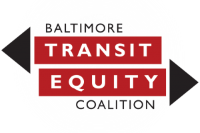what is a brta?
Baltimore Regional Transportation Authority
The Baltimore Regional Transportation Authority is a regional governing agency where public transit decisions would be made by and for the people of the region whom it serves. This agency would be able to set their own budget, apply for federal funds, and choose transportation projects that will serve the people in the region where they live.
A BRTA would provide the Baltimore Region with access to economic opportunity and an improved quality of life.
the problem
Our current, state-run transportation systems in the Baltimore Region are deeply inadequate.
If you don’t own a car, it’s nearly impossible to get around. Bus and rail lines offer unreliable service, are in disrepair, and don’t take people where they most need to go. To top this off, the transportation service that is offered is concentrated in mostly white and affluent neighborhoods –and many low-income communities of color in east and west Baltimore have barely any service at all.
Residents of these east/west neighborhoods have nearly double the commute time as residents in other areas of the city. To account for late or inconsistent bus schedules, After a 90-minute commute, these folks have to get to work 1.0 – 1.5 hours before their shift begins! BTEC calls this “unpaid transit-detention”. On top of this, automobile-centered systems exacerbate many of the problems these communities already face, making it harder to access the jobs, health services, and clean air that folks need to live.
For decades, they have prioritized spending money on highways that serve wealthy folks in the county over funding the public transportation systems that the region needs. At the same time, they have consistently underfunded our bus and light rail service and let things fall into dangerous disrepair. Because these leaders don’t have a vested stake in the region, they have failed to make a plan to address the inequities in our current system. Year after year, despite gaping holes in our transportation infrastructure, the most they have offered our region is an extra bus route. But research shows that bus routes are a poor substitute for rail projects. Riders find them much less convenient and they don’t produce the same kind of economic development as rail projects.
The Solution
The region needs a system that serves our communities’ needs – one that gives us more say in choosing the transportation projects that work for us and allows us to revive the Red Line! In short, we need a regional governance system through a Baltimore Regional Transportation Authority.
Regional governance over transit is not a radical idea. Most other major cities in America allow local or regional jurisdictions to have some control over transportation systems. It’s this regional governance that allows robust, multimodal transportation systems to thrive!
BRTA Now

With a Baltimore Regional Transportation Authority, we could set our own budget, apply for federal funds, and choose the transportation projects that serve us. Our BRTA would offer proportional representation of the region’s transit riders. It would also be set up to prioritize intersectional issues involved in creating transit equity. Under our plan, community members with experience in environmental justice, racial justice, public health, labor organizing, fair housing, and economic development would work together to develop the regional governance system.
How do we do this, you might wonder? Through a ballot initiative. The first step in the process is for us to gather 10,000 signatures from registered voters. These signatures will allow us to put a question about a BRTA on the November 2024 city ballot. If city residents vote yes on the question, the city will be compelled to give a commission of community leaders (with experience described above) an annual sum of money to begin planning a new regional governance structure. As part of that process, commissioners will work with regional jurisdictions to take the necessary steps for reviving the Red Line project, revisiting the environmental impact plan and the record of decision.
